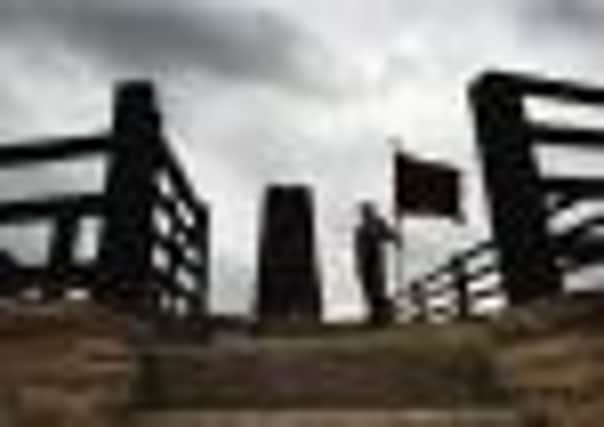Malcolm Barker: Written in stone, the humbling story of the men who gave their lives for us


Many miles away in Whitehall, London, stands the Cenotaph, a brilliant concept of the architect Sir Edwin Lutyens, a pylon of sublimely cut and pointed Portland stone.
Here the Queen will lead the nation and the Commonwealth in an Act of Remembrance on Sunday, the 59th Remembrancetide of her reign.
Advertisement
Hide AdAdvertisement
Hide AdThey are far apart in concept and situation. Yet both have a common purpose, for the Yorkshire tower commemorates the Leeds Pals’ Battalion of the West Yorkshire Regiment, raised in the city amid great enthusiasm in 1914, trained at Colsterdale, and winnowed almost to a man by German machine guns on the first day of the Somme, July 1, 1916.
They are important, these memorials, and are attracting greater attention with the advance towards the centenary of the outbreak of the Great War in 2014.
There is a vast number of them throughout the land, one estimate putting the total at 100,000. Many are in danger of being vandalised, stripped of their metal, neglected, or simply forgotten.
Most were funded by local communities, and they took many different forms. Harrogate, for example, raised a vast and gleaming column which spears the centre of town like a dart scoring a bull’s eye; Normanby, an old iron-stone mining community near Middlesbrough, much less well-to-do, inscribed the names of its 33 dead on a tablet mounted on the wall of a house in High Street.
Advertisement
Hide AdAdvertisement
Hide AdThere has long been concern for our memorials, although many are lovingly cared for. Even the remote Leeds Pals’ memorial has good friends, including a couple who were there last month, planting more daffodils to supplement the array that brings colour and movement to the site in spring-time. They are following a tradition.
Until his death in 1952, Edgar Chapman of Grewelthorpe, who served with the Pals and was wounded on the Somme, took care of the stone tower, ensuring it was in good order for an annual service on July 1.
But all monuments should have friends, and this need was answered in 1997 with the establishment of what has become the War Memorials Trust, which administers grants funded by the Trust itself, English Heritage and the Wolfson Foundation. An example of its work is to be seen at St Nicholas’, Husthwaite, near Easingwold, where Robert Thompson of Kilburn’s memorial cross has been renovated and repaired by the Parochial Church Council with a grant from the Trust. Among those commemorated are two brothers called Hebblethwaite who died within eight months of each other on the Western Front. There is also a Royal Marine, Cecil Stockdale, who was serving aboard HMS Good Hope when she was sunk by German warships off the Chilean coast in November 1914.
Various organisations are involved in attempts to catalogue the nation’s memorials. The “Lest We Forget” website, maintained by volunteers, lists them by county, including 74 in Yorkshire. Among these is a roadside cross in Arkengarthdale dedicated to five young Dalesmen, and a steel plate on the wall of the former Firth Brown Atlas Works in Sheffield, naming 147 steelworkers killed in the conflict. Most were soldiers, but Harry Clay exchanged the heat of the foundry for the boiler-room of a battleship. He was serving as a stoker on HMS Aboukir, on patrol on the North Sea’s Broad Fourteens on September 22, 1914, along with two other cruisers, HMS Cressy and HMS Hogue. All three were sunk by a German U-Boat. The death toll was 1,450, among them Harry Clay.
Advertisement
Hide AdAdvertisement
Hide AdBeck Isle Museum at Pickering is engaged on recording the Great War memorials of the Green Howards, a huge task, for 65,000 men served with the regiment during that conflict, of whom 7,500 were killed and 23,000 wounded. Across the Tees, the North East War Memorial project is seeking to trace every commemoration between that river and the Tweed.
As a result of these and manifold other efforts, a vast repository of such information is developing on the internet, and contributors sometimes bring names forward from the shadows by adding brief details, such as the home-towns of the fallen, where and when they were killed, and the names of their parents.
Stokesley’s Book of Remembrance, kept at the Parish Church, demonstrates the value of such detail. The compiler, Charles William Hall, was determined to ensure young friends of his childhood should not be remembered just as names, but as people. He put their pictures on left-hand pages and wrote about them in copper-plate on facing pages. He illuminated the book throughout with drawings of flowers and country scenes, creating a tribute like no other.
Mr Hall died in the war of 1939. He was a member of the design team at Smith’s Dock, Middlesbrough, and perished in 1940 when a corvette under trial exploded and sank within minutes.
Advertisement
Hide AdAdvertisement
Hide AdSomething similar to his album was made at Danby in the Esk Valley. A poignant entry refers to Fred Hodgson as “one of the bright and promising boys at Danby school”. He joined up before he was 18, and was killed by poison gas. This rare tribute is paid to Fred: “A star lost in the dawn.”
The Leeds Pals were at Colsterdale during the winter of 1914-15. They arrived as excited lads in flat caps and black armbands. They had been cheered off by thousands, and had had their names, all 1,275 of them, printed in the Yorkshire Post. They marched out as soldiers with rifles at the slope, on their way, first to Suez, and then to France, where many remain, rank on rank, in graves in Picardy.
Their Colsterdale memorial may be humble. But its message is remembrance, and its effect humbling.